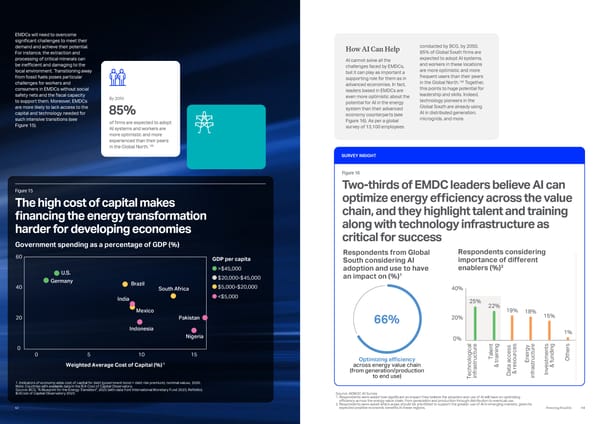By 2050 of firms are expected to adopt AI systems and workers are more optimistic and more experienced than their peers in the Global North.109 85% EMDCs will need to overcome significant challenges to meet their demand and achieve their potential. For instance, the extraction and processing of critical minerals can be inefficient and damaging to the local environment. Transitioning away from fossil fuels poses particular challenges for workers and consumers in EMDCs without social safety nets and the fiscal capacity to support them. Moreover, EMDCs are more likely to lack access to the capital and technology needed for such intensive transitions (see Figure 15). The high cost of capital makes financing the energy transformation harder for developing economies Figure 15 How AI Can Help AI cannot solve all the challenges faced by EMDCs, but it can play as important a supporting role for them as in advanced economies. In fact, leaders based in EMDCs are even more optimistic about the potential for AI in the energy system than their advanced economy counterparts (see Figure 16). As per a global survey of 13,100 employees conducted by BCG, by 2050, 85% of Global South firms are expected to adopt AI systems, and workers in these locations are more optimistic and more frequent users than their peers in the Global North.109 Together, this points to huge potential for leadership and skills. Indeed, technology pioneers in the Global South are already using AI in distributed generation, microgrids, and more. SURVEY INSIGHT Two-thirds of EMDC leaders believe AI can optimize energy efficiency across the value chain, and they highlight talent and training along with technology infrastructure as critical for success Figure 16 Respondents from Global South considering AI adoption and use to have an impact on (%)1 Respondents considering importance of different enablers (%)2 66% Optimizing efficiency across energy value chain (from generation/production to end use) 40% 25% 22% 19% 18% 15% 1% 20% 0% Others Investments & funding Energy infrastructure Data access & resources Talent & training Technological infrastructure do not go over red part (this figure specifically has a reduced width) do not go over red part (this figure specifically has a reduced width) >$45,000 GDP per capita $20,000-$45,000 $5,000-$20,000
 Powering Possible 2024: AI and Energy for a Sustainable Future Page 32 Page 34
Powering Possible 2024: AI and Energy for a Sustainable Future Page 32 Page 34